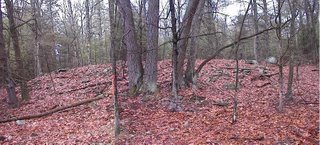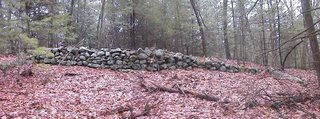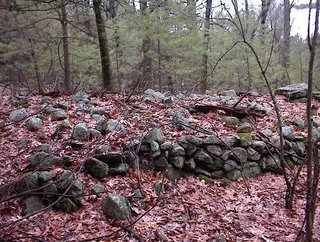In one part of the book Mitchell discusses a "serpent mound" snaking back and forth through the woods. For a number of us, this discussion was one of the things that first got us out exploring the woods looking for unusual mounds and - as it turns out - rock piles. I eventually located what I thought Mitchell must have been writing about and for several years I have been under the impression the so-called "Serpent Mound" was actually a berm of cobbles that was curved but was not really "snaking through the woods". Well I have a couple things to announce. One is that I was wrong, Mitchell was right. I took a closer look at his mound this weekend and it does indeed curve back-and-forth and has at least two points of inflection along it. The second announcement is that there are at least two more long curved (although not necessarily re-curved) rock piles in the same vicinity.
Here is the best shot I could get of Mitchell's "Serpent Mound". Note the "head" at the far right.
 Here is a detail of the "head":
Here is a detail of the "head":
I was exploring in the same area, around Fort Pond in Littleton, this weekend. I figured other woods near the Sarah Doublet Forest might be just as interesting. In fact I came across a major concentration of large-scale effigies which is, as yet, private property. It definately should be part of the Littleton Conservation land.
I will give you a site description in a bit. For now I want to show you these "serpents" - actually long, curved, low, rock piles, with a prominent larger "head" rock at one end. Here is one of them. This view from below is the best shot I can get showing the entirety of the pile.
 And then here is another nearby.
And then here is another nearby. I realize that these last two piles are not very similar. This last one is a good deal like what Geophile mentioned as a "whatsit" or a "fishtail". It almost seems like a road edge - stabilized on the slope; or like a bit of terracing. But it is not any of those things. Here is another view:
I realize that these last two piles are not very similar. This last one is a good deal like what Geophile mentioned as a "whatsit" or a "fishtail". It almost seems like a road edge - stabilized on the slope; or like a bit of terracing. But it is not any of those things. Here is another view: I am probably completely mis-identifying this pile. I like it a lot because I was looking for "whatsits" and here I finally found a good one. It may not be a serpent or even an effigy. However, it was near another "whatsit", and I strongly favor the idea that these are representations of different subjects.
I am probably completely mis-identifying this pile. I like it a lot because I was looking for "whatsits" and here I finally found a good one. It may not be a serpent or even an effigy. However, it was near another "whatsit", and I strongly favor the idea that these are representations of different subjects. [I am sorry for the lousy picture, barely giving a sense of the overall pile.]
[I am sorry for the lousy picture, barely giving a sense of the overall pile.]At any rate, I wanted to leave you with two thoughts. One was that this new site is an important adjunct to what we see at Sarah Doublet Forest - and which Mitchell made famous. The other is that collections of large effigy-like rock piles can contain serpents as well as turtles.
Mitchell also mentions a turtle pile near his "serpent". There are actually two piles that could be turtles. I think this is the one referred to in "Tresspassing".
 An entire post could be written about this pile - including its location near the "serpent"; the damage it has - suggesting someone looked for buried treasure in it; the single white cobble on its back. For now, let's just note it is built a few yards from the head of the "serpent".
An entire post could be written about this pile - including its location near the "serpent"; the damage it has - suggesting someone looked for buried treasure in it; the single white cobble on its back. For now, let's just note it is built a few yards from the head of the "serpent".
1 comment :
This is very interesting. And you're right--that thing does look like the whatsits or 'fishtails' I've seen down here.
I see some of your stuff, and I realize I've probably stepped right over features without noticing them while looking at other stuff.
Post a Comment